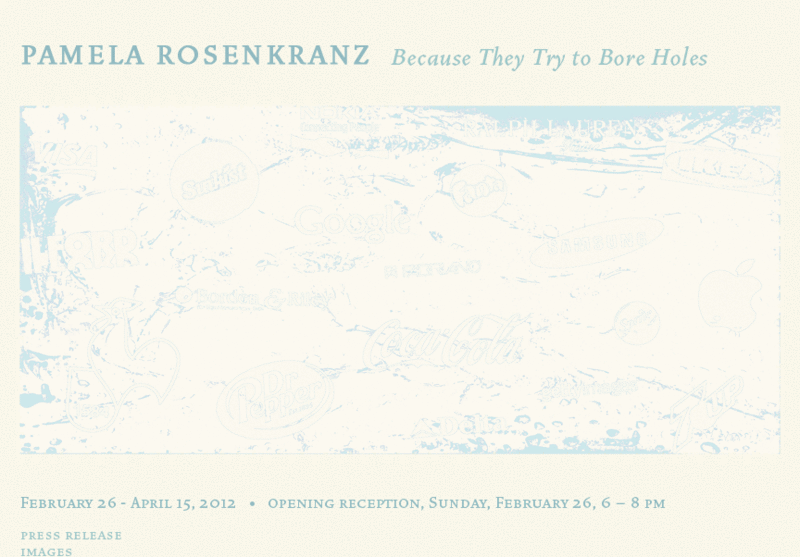Pamela Rosenkranz
26 Feb - 15 Apr 2012
PAMELA ROSENKRANZ
Because They Try to Bore Holes
26 February - 15 April, 2012
As the world submits more and more to the abstractions of capital, the interconnectivity of digital networks, and the promises of the experience economy, the body responds by lying down.
- Alex Kitnick
Miguel Abreu Gallery is pleased to announce the opening, on Sunday, February 26th , of Because They Try to Bore Holes, Pamela Rosenkranz’s first solo exhibition at the gallery. The show will run through April 15th and will feature new works that “take the form of paintings and sculptures, but do not themselves begin with these terms.”1
Framed works made of repurposed materials, such as adhesive photomount hand-applied to blank Ilford photo paper, and various soft drinks mixed with Ralph Lauren latex paint covering inkjet printed paper, will beinstalled alongsidesculptures made of hand-warped acrylic glass sheets and Ikea furniture parts boxed in their original cardboard packaging, itself painted in decorative shades of white. Throughout the exhibition, Rosenkranz confronts painting and sculpture’s traditional address to human-scale, alienating its convention through her material treatment of the objects at hand.
As the title indicates, the show refers to Yves Klein’s statement in his ‘Chelsea Manifesto,’ that the birds passing across the bright Mediterranean sky above him "tried to bore holes in my greatest and most beautiful work,”that is, the blue sky itself! For Rosenkranz, Klein functions as the model for a brand of modern and contemporary art that firmly positions at its core the artist and his or her subjectivity. She displaces the seemingly subjectivist gesturality of her own work by openly reducing the signs it is capable of producing to their evolutionary and capitalist conditions of production. Through the use of fossil images, degraded to the point of illegibility by layers of brand name decorative paint and sugar-rich soft drinks, Rosenkranz’s works struggle to ground and undermine an idea of art that purports to transcend its immediate materiality. Mass-market consumer brands abound rendering explicit the complicity between the artwork and its subsumption into an increasingly mystified field of corporate identities. Soft drinks, for instance point to the metabolic currency that underlies the conception, production, and perception of the artwork. The brain requires energy, she affirms, and therefore needs sugar to burn. In other words, glucose must be burned in order to generate, develop and view the work. In this sense, Rosenkranz collapses the potential meaning of an artwork to its meaningless material elements. And here it lies; and from here it goes.
Because They Try to Bore Holes
26 February - 15 April, 2012
As the world submits more and more to the abstractions of capital, the interconnectivity of digital networks, and the promises of the experience economy, the body responds by lying down.
- Alex Kitnick
Miguel Abreu Gallery is pleased to announce the opening, on Sunday, February 26th , of Because They Try to Bore Holes, Pamela Rosenkranz’s first solo exhibition at the gallery. The show will run through April 15th and will feature new works that “take the form of paintings and sculptures, but do not themselves begin with these terms.”1
Framed works made of repurposed materials, such as adhesive photomount hand-applied to blank Ilford photo paper, and various soft drinks mixed with Ralph Lauren latex paint covering inkjet printed paper, will beinstalled alongsidesculptures made of hand-warped acrylic glass sheets and Ikea furniture parts boxed in their original cardboard packaging, itself painted in decorative shades of white. Throughout the exhibition, Rosenkranz confronts painting and sculpture’s traditional address to human-scale, alienating its convention through her material treatment of the objects at hand.
As the title indicates, the show refers to Yves Klein’s statement in his ‘Chelsea Manifesto,’ that the birds passing across the bright Mediterranean sky above him "tried to bore holes in my greatest and most beautiful work,”that is, the blue sky itself! For Rosenkranz, Klein functions as the model for a brand of modern and contemporary art that firmly positions at its core the artist and his or her subjectivity. She displaces the seemingly subjectivist gesturality of her own work by openly reducing the signs it is capable of producing to their evolutionary and capitalist conditions of production. Through the use of fossil images, degraded to the point of illegibility by layers of brand name decorative paint and sugar-rich soft drinks, Rosenkranz’s works struggle to ground and undermine an idea of art that purports to transcend its immediate materiality. Mass-market consumer brands abound rendering explicit the complicity between the artwork and its subsumption into an increasingly mystified field of corporate identities. Soft drinks, for instance point to the metabolic currency that underlies the conception, production, and perception of the artwork. The brain requires energy, she affirms, and therefore needs sugar to burn. In other words, glucose must be burned in order to generate, develop and view the work. In this sense, Rosenkranz collapses the potential meaning of an artwork to its meaningless material elements. And here it lies; and from here it goes.

